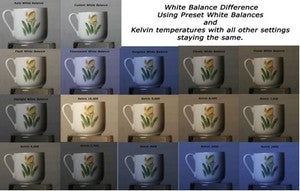Photography 101: White Balance
The second choice is a custom white balance. Custom white balance sounds complicated but is easy to set. The camera will ask you to select a file from the card in your camera to set as what you want to base your white balance on, select the shot of gray you just took and you’re done.

White Balance is an important part of digital photography. While our eyes adjust to different light, cameras don’t always interpret white correctly. So in-camera white balance is in place to compensate.
(click to enlarge)
The most common or default option is AWB or auto white balance, where the camera judges the light and adjusts the white balance accordingly. With improved technology this setting is pretty accurate, but can some times fail to give you the result you’re looking for.
The second choice is a custom white balance. Custom white balance sounds complicated but is easy to set. You take a picture of a neutral gray in the light that you will be shooting (either carry an 18% gray card ($35, street), or find a neutral gray like a sidewalk), set your camera to custom and choose from the menu custom white balance. The camera will ask you to select a file from the card in your camera to set as what you want to base your white balance on, select the shot of gray you just took and you’re done.
The third choice is to set the Kelvin temperature of the light. The basic Kelvin temperatures range from 1,000K for candlelight to 10,000K for shady or heavily overcast sky with daylight right in the middle at 5,000K.
The final option is to use the preset white balance options on your camera, all cameras have several, such as sunny, cloudy, fluorescent, etc.